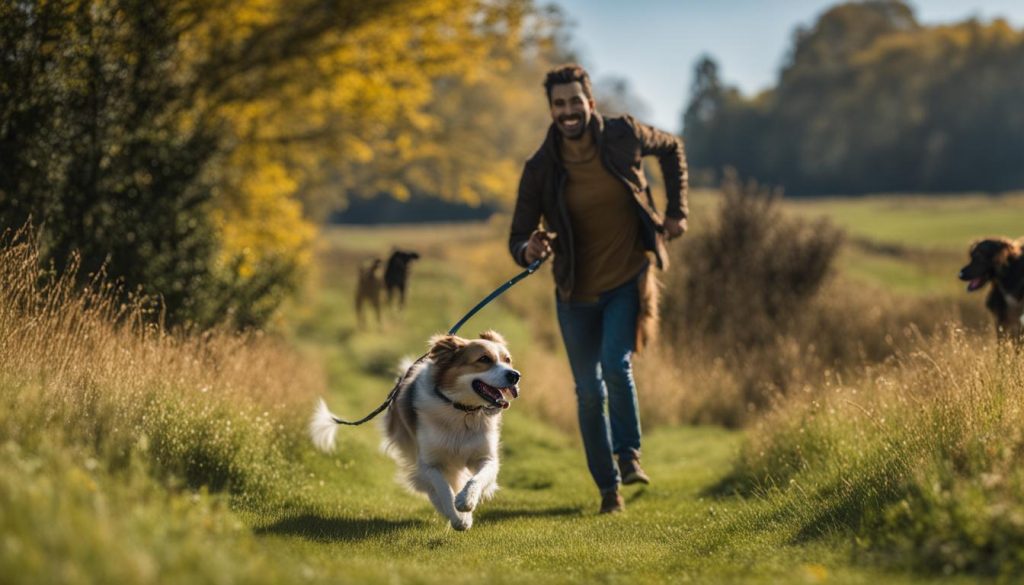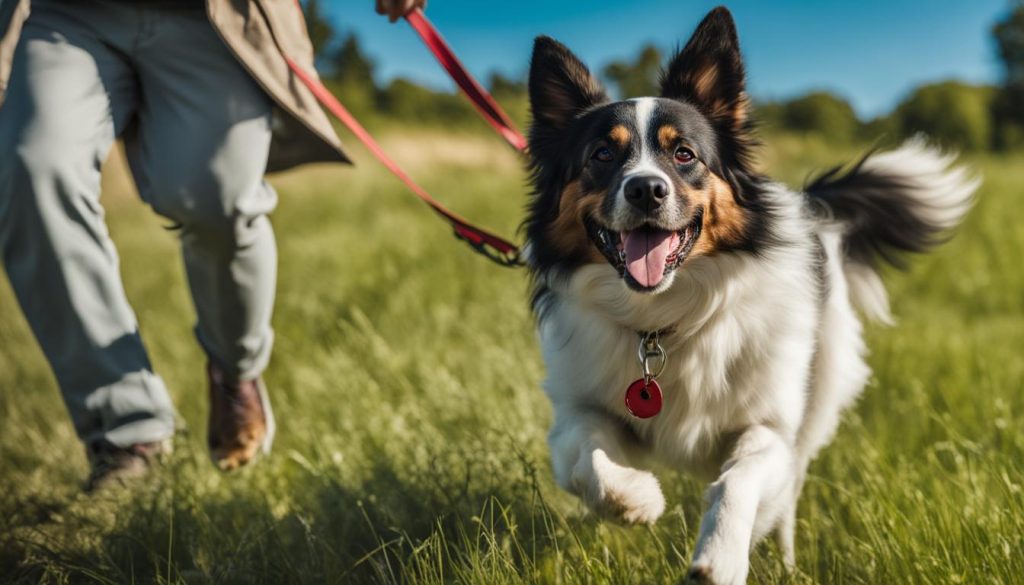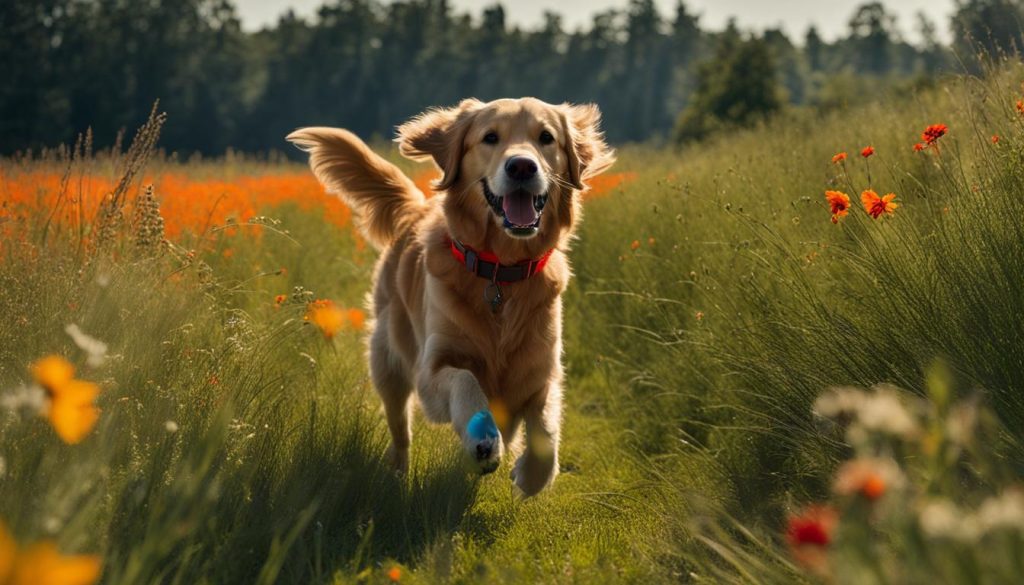Training your dog to walk off leash can be a challenging but rewarding process. You should ensure your dog’s safety and the safety of others while allowing them the freedom to explore. There are several steps you can take to successfully teach your dog to walk off leash.
Key Takeaways:
- Off leash dog training can provide mental and physical benefits for your dog.
- Consider your dog’s temperament, health, and prey drive before attempting off leash walking.
- Establish a foundation of obedience training before starting off leash training.
- Master the recall command and teach your dog to stay close and check in with you regularly.
- Gradually introduce off leash walking in a safe and enclosed area, gradually increasing duration and adding distractions.
The Importance of Off Leash Training
Off leash training for dogs is not just about allowing them the freedom to roam and explore without a physical restraint. It is a crucial aspect of their mental and physical well-being. Dogs are naturally curious and active animals, and off leash walking provides them with a chance to satisfy their need for exploration and exercise.
However, you should note that not all dogs are suitable candidates for off leash walking. Factors such as temperament, health, and prey drive should be taken into consideration. Some dogs may be more prone to running off or getting into dangerous situations, while others may have difficulty responding to verbal commands.
Off leash training plays a significant role in reducing the chances of your dog getting lost, injured, or causing harm to others. It teaches them to stay close to you or respond to your voice, even when distractions are present. This level of control is vital in ensuring their safety and the safety of those around them.

The Benefits of Off Leash Training
Off leash training offers numerous benefits for both dogs and their owners. Here are some key advantages:
- Improved physical fitness: Off leash walking allows dogs to engage in more natural movements, run, and play freely, promoting better physical health and agility.
- Mental stimulation: Exploring new environments and encountering various scents, sights, and sounds during off leash walks can provide mental enrichment for dogs, preventing boredom and destructive behaviors.
- Enhanced bond: Off leash training strengthens the bond between dogs and their owners by promoting trust, communication, and teamwork.
- Increased socialization: Off leash walks provide opportunities for dogs to interact with other dogs and people in a controlled and supervised environment, helping to improve their social skills.
With proper training and gradual introduction, off leash walking can be a rewarding experience for both you and your furry companion.
Building a Foundation of Obedience Training
Before attempting off leash training, it is good practice to establish a strong foundation of obedience training for your dog. This foundation will provide the necessary skills and behaviors for successful off leash walking. By mastering basic commands such as loose leash walking, heel, recall, leave it, and stay, your dog will be better equipped to handle the freedom and responsibility of being off leash.
Clicker training can be an effective method for teaching these obedience commands. The use of a clicker, a small device that makes a distinct clicking sound, helps to reinforce desired behaviors and communicate effectively with your dog. By pairing the clicker with treats, you can reward your dog for executing each command correctly, making the training process more enjoyable for both of you. Try to be consistent and patient during the training sessions, as building a strong foundation takes time and effort.
Implementing Clicker Training
Clicker training involves a simple process:
- Teach your dog that the sound of the clicker signifies a reward.
- Establish a clear association between the desired behavior and the clicker.
- Reinforce the behavior by providing a treat immediately after the click.
- Repeat the process consistently to reinforce the behavior and help your dog understand the command.
By using clicker training, you can effectively teach your dog the necessary obedience commands for off leash walking. This positive reinforcement method encourages your dog to learn and respond to commands willingly, creating a strong bond and trust between you and your furry companion.

Table: Comparison of Basic Obedience Commands
| Command | Description |
|---|---|
| Loose Leash Walking | Teaches your dog to walk calmly without pulling on the leash. |
| Heel | Teaches your dog to walk closely by your side, with their shoulder aligned with your leg. |
| Recall | Teaches your dog to come to you promptly when called, even in distracting environments. |
| Leave It | Teaches your dog to ignore and avoid picking up or interacting with unwanted objects or substances. |
| Stay | Teaches your dog to remain in a designated position until given a release command. |
Teaching Recall and Staying Close
When it comes to off leash walking, teaching your dog reliable recall is of utmost importance. Recall is the command that ensures your dog will come to you when called, even in distracting environments. To train recall effectively, start in a quiet and familiar area where your dog feels comfortable.
Begin by using a consistently positive and encouraging tone of voice when calling your dog’s name followed by the “come” command. You can also use a specific recall cue word or phrase, such as “here” or “come to me.” When your dog responds and comes to you, reward them with praise and treats as positive reinforcement.
As your dog becomes more reliable in their recall, gradually increase the level of distractions they encounter during training sessions. This can include practicing recall in different environments, such as local parks or busy streets, where there may be other dogs, people, or enticing scents. This will help your dog learn to ignore distractions and focus on coming to you when called.
In addition to recall, it is also crucial to teach your dog to stay close and check in with you regularly during off leash walks. The “look” command can be helpful in achieving this. Start by saying “look” and rewarding your dog when they make eye contact with you. Practice this command in various locations and gradually increase the distractions present to reinforce staying close and checking in with you.

| Off Leash Walking Tips | Recall Training Tips |
|---|---|
|
|
Gradually introducing off leash walking
Once your dog has successfully mastered basic obedience training and recall, it is time to gradually introduce off leash walking. This stage of training is crucial for your dog to learn how to navigate and explore their surroundings while remaining under your control. Here are some important steps to follow when introducing off leash walking:
- Start in a secure and enclosed area: Begin by allowing your dog short periods of off leash time in a safe, fenced yard or a designated dog park. This controlled environment will help build your dog’s confidence and provide them with the freedom to explore without the risk of getting lost or running into potential dangers.
- Gradually increase duration and distractions: As your dog becomes more comfortable off leash, gradually increase the duration of their off leash time. You can also gradually introduce more distractions, such as other dogs or interesting scents, to test your dog’s focus and obedience.
- Use positive reinforcement: During off leash walking, you should continue using positive reinforcement to reward your dog for good behavior. Carry high-value treats or use verbal praise to reinforce their obedience and encourage them to stay close to you.
Keep in mind that off leash walking should always be done in a controlled and safe manner. You should be aware of your surroundings and any potential risks. If you are unsure about a particular environment or your dog’s behavior, it is best to keep them on a leash until you feel confident in their ability to stay under control. To put it simply, consistency and continued practice are key to successfully training your dog to walk off leash.

Benefits of off leash walking
Off leash walking provides numerous benefits for both you and your dog. It allows your dog to exercise and explore their surroundings more freely, promoting their mental and physical well-being. It also strengthens the bond between you and your canine companion, as you both navigate and experience the world together. Moreover, off leash walking can help improve your dog’s obedience, as they learn to stay close to you and respond to commands even when distractions are present. Ultimately, off leash walking can enhance your dog’s overall happiness and quality of life.
Common challenges and solutions
While off leash walking can be rewarding, it can also present some challenges. Some dogs may be easily distracted or prone to wander off, especially in new or stimulating environments. To address these challenges, you should reinforce your dog’s recall command and focus on building their impulse control. Regular training sessions and positive reinforcement can help improve your dog’s obedience and attention. Additionally, utilizing long training leads or remote training collars can provide an extra level of security and control during off leash walking.
Safety Precautions for Off Leash Walking
When it comes to off leash walking, ensuring the safety of your dog and others is paramount. By following these safety precautions, you can minimize potential risks and enjoy a worry-free off leash experience with your canine companion.
Safety Precautions:
- Know and follow leash laws in your area. I recommend that you understand the rules and regulations pertaining to off leash walking in your specific location. This will help you avoid any legal issues and maintain a safe environment for everyone.
- Choose open areas with natural boundaries. When selecting a location for off leash walking, opt for spacious areas with clearly defined boundaries, such as fenced-in parks or designated off leash areas. This will ensure that your dog has plenty of space to explore while reducing the risk of them wandering off into dangerous territory.
- Avoid crowded public spaces and heavy traffic areas. To minimize potential hazards, steer clear of crowded areas where your dog may encounter unpredictable or fearful situations. It’s also important to avoid busy streets and heavy traffic areas, as these pose risks for both you and your dog.
- Be mindful of your dog’s tendencies and limitations. Every dog is unique, and please consider your dog’s individual tendencies and limitations. If your dog has a high prey drive, for example, be cautious in areas with wildlife or smaller animals. Similarly, if your dog is fearful or reactive, take extra precautions to ensure their safety and the safety of others.
- Carry a leash for emergencies. While the goal of off leash walking is to give your dog freedom, it’s always wise to be prepared for unexpected situations. Carry a leash with you at all times, even when your dog is off leash, so that you can quickly regain control if necessary.
By implementing these safety precautions, you can foster a safe and enjoyable off leash walking experience for you and your dog. To put it simply, the key to successful off leash training is a combination of proper preparation, ongoing training, and prioritizing your dog’s safety at all times.

| Safety Precautions for Off Leash Walking | |
|---|---|
| Know and follow leash laws in your area | ✔ |
| Choose open areas with natural boundaries | ✔ |
| Avoid crowded public spaces and heavy traffic areas | ✔ |
| Be mindful of your dog’s tendencies and limitations | ✔ |
| Carry a leash for emergencies | ✔ |
Consistency and continued practice
Consistency and continued practice are key when it comes to successfully training your dog to walk off leash. By maintaining a regular training routine and reinforcing obedience commands, recall, and off leash behaviors, you can help your dog become more reliable and confident in their off leash walking abilities. Consistency is important because it helps to establish clear expectations for your dog and reinforces their understanding of the desired behaviors.
As you continue to practice off leash training with your dog, gradually increase the difficulty of training exercises. Introduce new environments and distractions to help your dog generalize their off leash skills. By exposing them to different scenarios, you can ensure that they are able to follow commands and stay focused regardless of the situation.
It is also important to regularly review and reinforce basic obedience commands. By keeping these skills sharp, you can provide a strong foundation for off leash training. Try to always reward your dog for good behavior and use positive reinforcement techniques to encourage them to continue exhibiting the desired behaviors.
Off leash training requires ongoing effort, patience, and dedication. It may take time for your dog to fully grasp the concept and become reliable off leash. Be patient with them and continue to work on their training in a positive and consistent manner. With time and practice, you and your dog can enjoy the freedom and joy of walking together without a leash.

| Consistency and Continued Practice | Benefits |
|---|---|
| Regular training routine | Establish clear expectations |
| Gradually increase difficulty | Help generalize off leash skills |
| Review and reinforce obedience commands | Provide a strong foundation |
| Patience and dedication | Enjoy the freedom of walking without a leash |
The importance of off leash training
Training your dog to walk off leash is an important step towards providing them with mental and physical stimulation. Dogs thrive when they have the freedom to explore and engage in natural behaviors. Off leash walking allows them to run, play, and socialize in a controlled environment. However, it is good practice to ensure that your dog is well-behaved and responsive to commands before attempting off leash walking.
A well-trained dog is more likely to stay close to you and respond to your voice commands, reducing the risk of accidents or encounters with other animals or people. Before starting off leash training, make sure your dog has mastered basic obedience commands such as sit, stay, and recall. Building a solid foundation of obedience training will ensure that your dog understands boundaries and is capable of following instructions.
Additionally, off leash training can help strengthen the bond between you and your dog. It requires consistent communication, positive reinforcement, and trust. By dedicating time and effort to train your dog to walk off leash, you are investing in a stronger and more enjoyable relationship with your furry friend.

Safely and Responsibly Off Leash
When walking your dog off leash, it is essential to prioritize safety and be a responsible pet owner. Always research and follow local leash laws and regulations. Choose appropriate locations for off leash walks, such as secure and enclosed areas like designated dog parks. Avoid crowded areas or places with heavy traffic to minimize the risk of accidents.
Be aware of your dog’s temperament and potential triggers. If your dog has a high prey drive or is reactive towards other dogs or people, it may be best to keep them on a leash or seek professional guidance to address these behaviors. Consistently reinforce recall commands and use positive reinforcement to reward your dog for staying close to you and responding to your cues.
Don’t forget that off leash training is an ongoing process. Practice regularly and gradually introduce new environments and distractions to ensure that your dog remains well-behaved and responsive. By following these tips and prioritizing safety, you can enjoy the benefits of off leash walking while providing your dog with a fulfilling and enriching experience.
Final Thoughts
To sum it up, training your dog to walk off leash is a process that requires time, patience, and consistency. By following the proper training steps and building a foundation of obedience, you can successfully teach your dog to walk without a leash. Try to prioritize your dog’s safety and adjust training methods as needed.
Off leash walking provides mental and physical stimulation for your dog, allowing them the freedom to explore and play. However, not all dogs may be suitable candidates for off leash walking, so you should consider factors such as temperament, health, and prey drive.
Building a strong obedience foundation, teaching recall and staying close, gradually introducing off leash walking, prioritizing safety precautions, and continuing consistent practice are all key elements in successfully training your dog to walk off leash. Socializing your dog and teaching them how to interact with other dogs and people also contribute to a positive off leash experience.
Don’t forget that training your dog to walk off leash is an ongoing process. Regular review and reinforcement of obedience commands, recall, and off leash behaviors are necessary to maintain a reliable response from your dog. By following these tips and prioritizing your dog’s well-being, you can enjoy the freedom and joy of unleashed walks with your furry friend.
FAQ
Is off leash walking suitable for all dogs?
Not all dogs may be suitable candidates for off leash walking. Factors such as temperament, health, and prey drive should be considered before attempting off leash training.
What basic commands should my dog master before off leash training?
You should establish a solid foundation of obedience training before attempting off leash walking. Basic commands such as loose leash walking, heel, recall, leave it, and stay should be thoroughly mastered by your dog.
How can I teach my dog to come when called?
Start in a quiet, familiar area and gradually increase distractions. Use positive reinforcement and reward your dog for coming to you. Consistency and practice are key to training a reliable recall.
How do I introduce off leash walking?
Start with short periods of off leash time in a secure location such as a fenced yard or a designated dog park. Gradually increase the duration and add more distractions as your dog becomes more comfortable and reliable off leash.
What safety precautions should I take during off leash walks?
Be aware of leash laws in your area and always follow them. Choose open areas with natural boundaries and avoid crowded public spaces or areas with heavy traffic. Be mindful of your dog’s tendencies and limitations. Always carry a leash with you for emergencies.
How often should I practice off leash training?
Off leash training is an ongoing process that requires consistency and continued practice. Regularly review and reinforce obedience commands, recall, and off leash behaviors with your dog.
Is socialization important for off leash walking?
Yes, proper socialization is essential for off leash walking. Ensure that your dog is friendly and well-behaved around other dogs, animals, and humans. Encourage positive interactions and reward good behavior.






